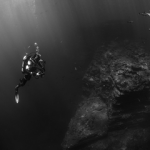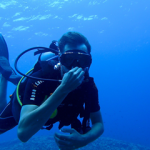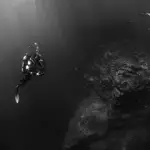
Is the bends the same as nitrogen narcosis?
Nitrogen narcosis shouldn’t be confused with decompression sickness or the bends. Both can happen to scuba divers. But even though the same gas nitrogen is involved, but what causes nitrogen narcosis vs decompression sickness (or the bends) is quite different.
Nitrogen narcosis vs the bends: The common denominator of nitrogen narcosis vs the bends is nitrogen. Nitrogen narcosis is caused by breathing air at pressure where the gas has an anaesthetic effect on the brain of a diver. Whereas decompression sickness is caused by nitrogen coming out of solution and forming bubbles on a divers ascent.
The best way to do more diving but avoiding the bends or nitrogen narcosis, is to book yourself on a scuba diving liveaboard. You can check the latest and best deals on liveaboards using the following window:
Nitrogen narcosis vs the bends – the similarities vs the differences
Nitrogen narcosis vs the decompression sickness; are they the same or are they different. But first let’s take a look at what is nitrogen narcosis and decompression sickness are.
What is nitrogen narcosis and decompression sickness?
Well let’s start of with nitrogen narcosis or the narks.
What is nitrogen narcosis?
Nitrogen narcosis generally occurs noticeably to divers at depths below 30 metres (98 feet) or deeper.
Scuba diving involves the breathing compressed air at pressure underwater. This pressure is caused by the density of water, where the pressure increases the deeper the dive.
More Reading: What causes nitrogen narcosis? (Is ‘raptures of the deep’ dangerous?)
It’s this breathing of air under pressure that impacts how much of the nitrogen molecules are dissolved into the tissues and blood. This extra nitrogen finds its way to your brain. Where too much nitrogen can affect the brain and causes an anaesthetic effect at increased pressure.
More Reading: How does a diver feel when narked (Is it Euphoric, Terrors or Crazy?)
What is the bends or decompression sickness?
The cause of decompression sickness, which is also called the bends, is from nitrogen bubbles forming in the bloodstream and tissues of the body.
These nitrogen bubbles form if you ascend too quickly from deep water after a dive. Alternatively, the bends occurs if you fail to carry out decompression stops at the appropriate depth and for the correct time on your ascent.
More Reading: How Deep Can You Dive Without Decompression (No Decompression Stop Limits)
The reason why bubbles form is because the pressure of the surrounding water decreases as you ascend. If the pressure falls too quickly (i.e. you do a fast ascent), the dissolved nitrogen is released too quickly and forms potentially deadly bubbles.
If however you ascend at the correct ascent rate and carry out the correct decompression stops, the nitrogen is released slowly enough that these nitrogen bubbles don’t form.
More Reading: 12 Decompression Sickness Risk Factors In Scuba Diving and How to Avoid Them

Similarities of nitrogen narcosis vs the bends
There are one or two similarities of nitrogen narcosis vs the bends, which include:
- For both the narks and the bends, the symptoms are brought on by nitrogen gas.
- Both are affected by depth and pressure. The greater the depth and pressure, the greater the risk of both.
- Both are affected by the fact that air contains 78% nitrogen.
- The deeper the dive the more likely it is for a diver to get narked (or get nitrogen narcosis). Also, the deeper the dive the more chances there are of getting the bends on the ascent.
- Both decompression sickness and nitrogen narcosis can be fatal!
Differences of nitrogen narcosis vs decompression sickness
Here are a few differences of nitrogen narcosis vs the bends:
- The main difference is that nitrogen narcosis is brought about on the dive descent and during the dive. Whereas the bends can occur at the end of dive on ascent.
- Whilst both are brought on by nitrogen gas, nitrogen narcosis is caused by dissolved nitrogen. Whereas decompression sickness is caused at the point this dissolved nitrogen comes out of solution (i.e. it’s no longer dissolved in the body’s tissues) and forms bubbles.
- The effects from nitrogen narcosis is on the brain. Whereas the bends can affect any part of the body.
- The bends can be prevented by using a slow controlled ascent. Whereas any speed of ascent won’t affect nitrogen narcosis. (But Note: please always ascend slowly, as you never want to get the bends or decompression sickness due to a fast ascent!).
- Nitrogen narcosis can occur at the beginning of a dive. This is especially true once you descend below 30 metres (98 feet). Whereas the bends occurs at the end of a dive when the body is saturated with nitrogen.
- The bends can happen on the surface even after a dive is completed. Whereas nitrogen narcosis cannot, as the symptoms cease with essentially no aftereffects or permanent harm done on a diver’s ascent.
- You have to wait for 24 hours after a dive before you fly to fully decompress to avoid getting the bends. Whereas flying after a dive has no affect on nitrogen narcosis. (Please note: always allow 24 hours after a dive before flying for your own personal safety.)
More Reading: Why is decompression sickness called the bends? (2.8 in 10,000 dives)
I hope you enjoyed this article about nitrogen narcosis vs the bends
I’d love to hear from you. Tell us about your adventures of diving and snorkeling, in the comments below. Please also share your photos. Either from your underwater cameras or videos from your waterproof Gopro’s!
If this article hasn’t answered all of your questions. If you have more questions either about snorkeling or scuba diving (or specifically about nitrogen narcosis vs the bends), please comment below with your questions.
There will also be many more articles about scuba diving (and snorkeling) for you to read and learn about these fabulous sports.
Have fun and be safe!




